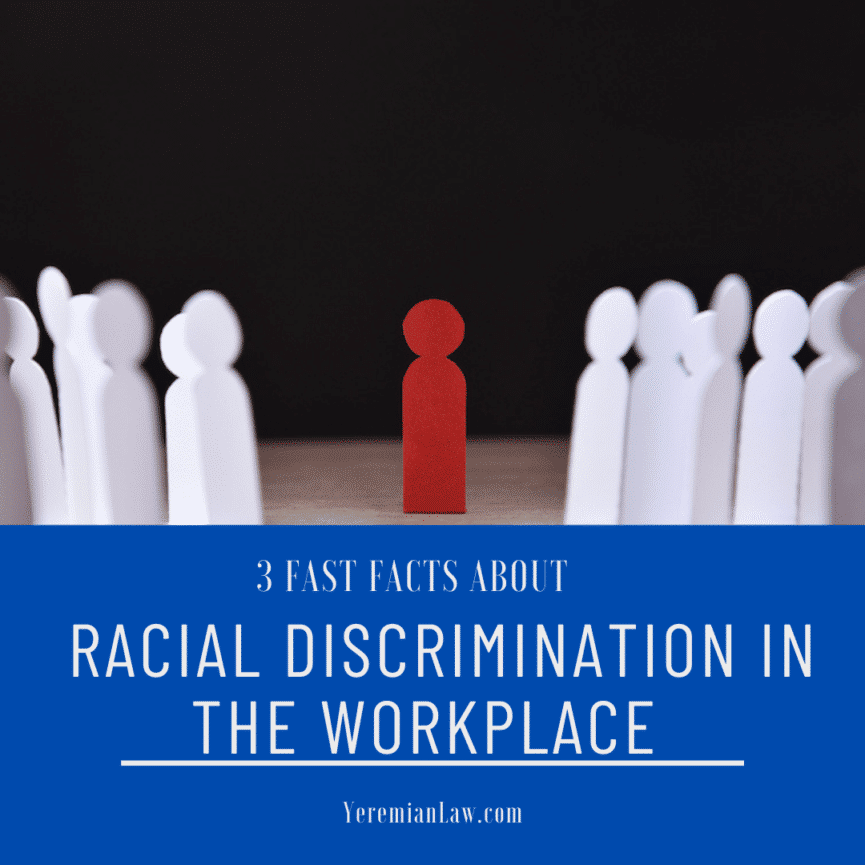If you’re like most people, you already know that racial discrimination in the workplace is illegal – employers are not allowed to discriminate against anyone based on that person’s race, color, national origin or ethnic background (or a whole host of other reasons). However, check out these three quick facts about racial discrimination in the workplace that aren’t so commonly known.
3 Fast Facts About Racial Discrimination in the Workplace
It’s unlawful to discriminate against an employee because of race, color, national origin and ethnic background when it comes to hiring, firing, promotions, compensation, job training, or any other term or condition of employment. Under Title VII of the Civil Rights Act of 1964, employers are required to keep all candidates and workers on a level playing field. Here are three fast facts about racial discrimination in the workplace and how it sometimes plays out:
- Discrimination on the basis of immutable characteristics associated with race is illegal.
- Color discrimination can occur between people of different or the same race or ethnicity.
- Employers cannot segregate or classify employees based on race.
Here’s a closer look at each.
1. Discrimination on the basis of immutable characteristics associated with race is illegal.
An immutable characteristic is any physical attribute that’s perceived as being unchangeable. For example, your eye color is an immutable characteristic (unless we start talking about colored contact lenses – but for the sake of this argument, let’s not). Your height, your eye shape, and your hair type are also immutable characteristics.
Although not all members of the same race share the same characteristics – for example, all European-Americans don’t have blond hair and blue eyes – employers are forbidden by law from discriminating against people with characteristics commonly associated with a certain race. That means a workplace policy that’s related to race (such as by skin color, certain facial features, or hair texture) may be discriminatory in nature.
The only exception is when the business can prove a bona fide business necessity. For example, a modeling agency representing a skincare line formulated for specific skin types is legally allowed to hire people with those skin types and exclude other people (those with non-matching skin types) from consideration.
2. Color discrimination can occur between people of different or the same race or ethnicity.
Color discrimination can occur between people of different colors or people of the same color, or between people of different or the same race or ethnicity. For example, color discrimination can exist even if the perpetrator has the same skin color or tone as the victim. (Title VII doesn’t specifically define “color,” but courts have traditionally considered the word to have its traditionally understood meaning: pigmentation, complexion, or skin tone or shade.)
Color discrimination occurs when a person is discriminated against because of the darkness, lightness, or other color-related characteristic of their skin. For example, an employer cannot refuse to hire a person with olive-toned skin, skin with blue undertones, or brown skin… unless a genuine business need exists.
3. Employers cannot segregate or classify employees based on race.
Employers are not permitted to segregate employees by physically isolating them from other workers or preventing them from making customer contact. For example, it would be illegal for a restaurant owner to hire only Caucasian people as servers, hosts and bartenders while only hiring African-American people for work in the kitchen. It’s also illegal to prevent employees of a certain race from interacting with customers in other positions, as well, even if the employer has genuine business concerns.
Do You Need to Talk to an Attorney About Racial Discrimination in the Workplace?
If you suspect you’ve been racially discriminated against, or if you’re not sure, give us a call at 818-230-8380 or fill out the form below. We’ll be happy to answer your questions during a free consultation – and we may be able to help you get the best possible outcome in your case.




